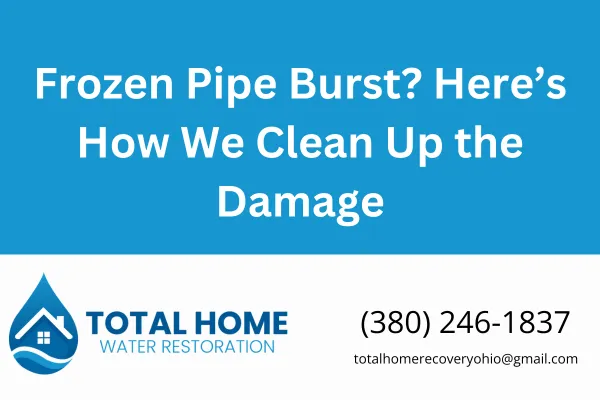
Frozen Pipe Burst? Here’s How We Clean Up the Damage
Frozen Pipe Burst? Here’s How We Clean Up the Damage
If you've just discovered water pouring from a burst pipe, stop reading for a second and shut off your main water supply. Once you’ve done that and called a plumber (or us directly), here’s what you need to know about what happens next—and how we clean up the damage properly.
At Total Home Water Restoration, we’ve seen hundreds of frozen pipe breaks across Grove City, Columbus, and surrounding areas. We know how fast it can go from “just a little water” to major structural damage if not handled right.
Here’s exactly how we tackle frozen pipe water cleanup:
Step 1: Stop the Leak, Then Assess the Damage
We work alongside your plumber to make sure the source is repaired. Once that’s done, we get to work:
Moisture mapping to find all the wet areas, even the ones you can’t see.
Thermal imaging to track how far the water spread through walls, floors, and ceilings.
Most burst pipe damage goes beyond what’s visible. Water travels fast.
Step 2: Immediate Water Extraction
We bring in high-powered pumps and vacuums to remove standing water fast. Speed matters—every hour water sits, the risk of mold and rot grows.
We’ve responded to calls where water from a pipe burst on the second floor ran down to the basement. The drywall, insulation, and flooring had to be removed. Acting fast saves you from that.
Step 3: Drying and Dehumidification
Using professional-grade air movers and dehumidifiers, we:
Dry the air and materials thoroughly.
Monitor moisture levels daily.
Adjust equipment until everything is verified dry.
According to IICRC S500 standards, drying must reach the “dry standard” for your material type—not just feel dry to the touch.
Step 4: Remove Damaged Materials (Only What’s Necessary)
We surgically remove wet drywall, trim, or flooring that can’t be saved. We don’t overcut. We aim to keep repairs minimal and cost-effective—just enough to prevent future problems like:
Hidden mold growth
Buckled floors
Soft or crumbling drywall
Step 5: Mold Prevention or Remediation
If mold has already started (which can happen within 24-48 hours), we follow IICRC S520 guidelines for safe, professional mold remediation. If caught early, we apply antimicrobial treatments to prevent it from starting at all.
Step 6: Repair and Rebuild
Once dry and clean, we repair:
Drywall and ceilings
Flooring and baseboards
Cabinets, paint, and trim
We rebuild it like we would our own home—with quality materials and careful work.
Real Talk from Tyler Zimmerman
“I’ve walked into homes where the ceiling caved in because of a frozen pipe. You don’t need to panic—but you do need to act fast and get it dried right. We’re here to make sure it’s done the right way from the start.”
FAQs About Frozen Pipe Cleanup
How long does it take to dry a flooded home?
Usually 3-5 days, depending on how much water and how quickly we can start.
Will insurance cover the damage?
Most policies cover sudden pipe bursts. We work with your adjuster and document every step to help with claims.
Can I just let it air dry?
Not safely. Drywall, insulation, and wood hold moisture that leads to mold and rot. You need professional drying.
Serving Central Ohio Homeowners
We serve:
Grove City
Columbus
Hilliard
Dublin
Upper Arlington
Pickerington
And nearby areas
Need help now? Call Total Home Water Restoration at 380-246-1837. We’re local, fast, and we fix it like it’s our own home.
